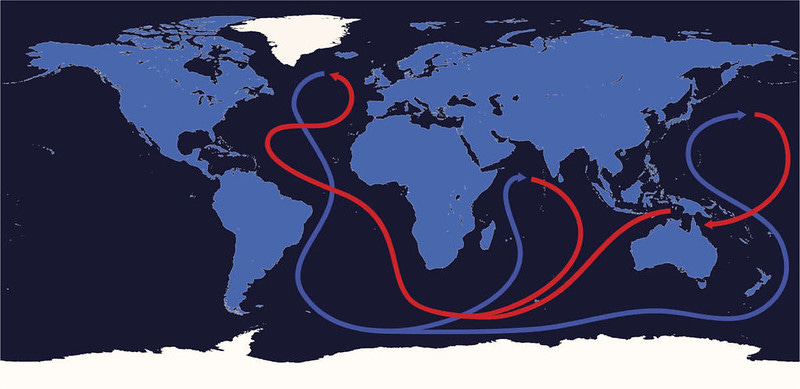Atlantic Current System Shutdown Risk “More Serious Than Many People Realize”
New studies suggest collapse of this oceanic conveyor belt could start within next few decades.
Credit: Felton Davis via Flickr, CC BY 2.0
The barrage of horrifying developments that seem to be happening on a near daily basis now under the second Trump administration underscore that we are living through a truly dark and precarious time. But as fascism tightens its grip here in the US and wars and genocide continue raging in Ukraine and Gaza, what must not get overlooked is the rapidly changing and destabilizing climate and physical breakdown of our planet’s life support systems. As climate scientist Peter Kalmus wrote in a Substack post back in June, “All this fascism and genocide is a horror, but it’s also a grand distraction as we all slowly cook to death on an overheating planet.”
Human civilization was simply not built for the type of climate conditions we are creating through our incessant use of fossil fuels that generate heat-trapping pollution, increasing Earth’s energy imbalance and unleashing widespread societal and ecological damage. As bad as all the death and destruction from climate-fueled disasters seem now, things are projected to get far, far worse as greenhouse gas emissions and global temperatures continue to climb – global heating is expected to reach around 3°C (above preindustrial levels) by the end of this century under current policies, a scenario that would be nothing short of catastrophic – and potentially unsurvivable, at least for large swaths of the population.
Two new studies out this week shed some light on one of the most alarming and most challenging to understand aspects of climate science – so-called “tipping points” – particularly around a critical ocean current system called the Atlantic meridional overturning circulation (AMOC). This Atlantic current system, which includes the Gulf Stream, is a major part of Earth’s climate system. It transports sun-warmed tropical water northward and returns colder, denser water back southward at depth. It acts like a kind of conveyor belt that helps keep Europe relatively mild and also influences weather patterns worldwide. But due to the climate crisis, this current system is now at its weakest in 1,600 years, and is even at risk of collapse.
A big uncertainty remains about when, or even if, this collapse would occur. If it were to occur, it had been considered unlikely to happen this century. Scientists at Utrecht University in the Netherlands, however, warn that the AMOC could beginning collapsing much sooner, within the next few decades. “An analysis consisting of 25 different climate models shows that the AMOC could begin to collapse by 2063 under an intermediate emission scenario or by 2055 under a high‐end emission scenario,” they write in a newly published study. “When the AMOC collapses, the Northwestern European climate changes drastically and this will likely induce severe societal impacts.”
Another study, published August 28 in Environmental Research Letters, similarly finds that the tipping point, when this Atlantic current system starts to heads towards unstoppable collapse, could be breached by the middle of this century. “In the simulations, the tipping point in key North Atlantic seas typically occurs in the next few decades, which is very concerning,” said Stefan Rahmstorf, scientist at the Potsdam Institute for Climate Impact Research and study co-author. Once that tipping point or threshold is crossed, the collapse of AMOC becomes inevitable due to self-amplifying feedbacks, even if the shutdown itself doesn’t happen until sometime after 2100.
“The deep overturning in the northern Atlantic slows drastically by 2100 and completely shuts off thereafter in all high-emission scenarios, and even in some intermediate and low-emission scenarios. That shows the shutdown risk is more serious than many people realize,” said Sybren Drijfhout of the Royal Netherlands Meteorological Institute and lead author of the study.
If or when the AMOC shuts down, it is expected to result in large, abrupt shifts to regional weather patterns, drying in Europe with some northern parts of the continent plunged into deep winter freeze, and major additional sea level rise along the US Atlantic coast. As Guardian environment editor Damian Carrington explained in an article reporting on the new study, collapse “would shift the tropical rainfall belt on which many millions of people rely to grow their food, plunge western Europe into extreme cold winters and summer droughts, and add 50cm to already rising sea levels.”
“A full AMOC collapse would be a massive, planetary-scale disaster. We really want to prevent this from happening,” Rahmstorf wrote in a piece published last year in Oceanography. “For the AMOC and other climate tipping points, the only action we can take to minimize the risk is to phase out fossil fuel use and stop deforestation as fast as possible.”
That of course is not happening, especially not in the United States where the Trump administration is doubling down on coal, oil, and gas – and pressuring other countries to do the same.
The AMOC collapse and other truly devastating consequences of climate breakdown may not happen in our lifetimes, but for today’s young children and newborns as well as future generations, the world they are inheriting is likely to be one of utter chaos and instability – a planet that is not safe and may not even be habitable in many places. It is important to be clear-eyed about the looming planetary disasters and collapses that are in store as the climate emergency unfolds, as horrifying as they may be, and then do everything we can to try to minimize the damages and the risks for the sake of today’s youth and those yet to come.


